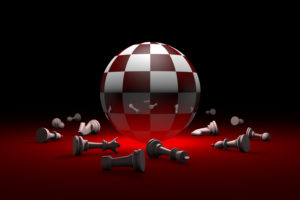 First things first, what is Brand Identity?
First things first, what is Brand Identity?
If we go with the technical definition according to the American Marketing Association, Brand Identity is defined as the representation of your company’s reputation through the conveyance of values, attributes, purpose, strengths and passions.
In laymen terms, your Brand Identity is what sets you apart from the rest of the noise out there.
Without it?
You’re just trying to scream louder than everyone without developing a voice that communicates with your target audience on a deeper level.
It’s not just about your product or service anymore. It’s about who you are, what you stand for, and why you do what you do.
Nowadays there is more noise and more competition than ever before. We went from an average of seeing 4-6 advertisements per day 50 years ago to seeing an average of 400 per day, just within the last few years.
 It’s safe to say that with so much competition for your audience’s attention now, that the new way to stand out is to RESONATE with them and make them feel understood by you on a deeper level. We are no longer in a transaction-based marketplace but rather a connection-based economy and in this new environment, Brand Identity is KING.
It’s safe to say that with so much competition for your audience’s attention now, that the new way to stand out is to RESONATE with them and make them feel understood by you on a deeper level. We are no longer in a transaction-based marketplace but rather a connection-based economy and in this new environment, Brand Identity is KING.
Let’s review…
We are no longer in a transaction-based marketplace but rather a connection-based economy. You have got to understand what this means! So, keep reading…
Customers are looking to engage and connect with the brands and businesses support, making it ever so crucial that businesses reciprocate with their audience.
In a transaction-based marketplace, people are willing to buy with you because it’s convenient, it’s simple and you have what they need.
Today, in our evolved connection-based economy, customers want to support the brands and businesses they are loyal to, even if it costs a little bit more or is slightly out of their way.
So, what is the best way to capitalize on this information and identify your brand identity?
Keep reading and you’ll soon understand the 4 major points that will help you craft your brand’s identity!
1. Identify Your Brand using Carl Jung’s 12 Archetypes

Chances are if you’ve ever seen a good movie, the entire story line was modeled after one of the 12 Archetypes. An archetype (which originated in Ancient Greece), is simply a universal stereotype used to tell stories that are relatable.
Here are the 12 archetypes as listed by Sparkol.com
1. The Innocent aka The Dreamer/Romantic – Think McDonalds
2. The Hero aka The Superhero/Warrior – Think Nike and Michael Jordan
3. The Regular Guy aka The Good Guy/Everyman – Think Carling
4. The Nurturer aka The Saint – Think Ford
5. The Creator aka The Artist – Think Apple
6. The Explorer aka the Seeker or Wanderer – Think The North Face or Indiana Jones
7. The Rebel aka Revolutionary or Outlaw – Think Harley Davidson
8. The Lover aka The Idealist – Think Victoria Secret
9. The Magician aka The Visionary – Think Disney
10. The Ruler aka The King/Leader – Think Rolex or American Express
11. The Jester aka The Fool/Comedian – Think Old Spice
12. The Sage aka The Wise Scholar – Think National Geographic
Now, I’m not going to go over every single archetype but here are some simple steps you can take towards defining which of these archetypes has the most affinity with your brand and your audience….
2. List Your Strengths

This may sound overly simplified but this is exactly what you need to convey to a message to your audience as quickly as possible.
Who are you?
Some questions to answer to help you define this are…
– Funny or Formal
– Big or Small
– Boring or Surprising
– Reserved or Outspoken
– Stylish or Classic
– Inexpensive or Premium
– Masculine or Feminine
– Young or Mature
Your audience should be able to identify exactly who you are with every marketing message that you send. Simplification is the way to go.
Next…
3. Define Your Customers Needs
Each of the Archetypes above ha an equivalent message that resonates with that specific audience.
For example, the Rebel Archetype most resonates with that audience’s need to FEEL as if they are not subjected to the same rules as everyone else.
A need to feel as if the rules don’t apply to them….you know, like those big, bad, long-haired tattooed Harley guys and gals?
The ones that rev their engines as the light turns green so the whole neighborhood knows that a Harley just drove by?
How about Victoria Secret?
It’s as simple as FEELING sexy or romantic!
From the sleek see-through lingerie to the sexy, exposing bras and underwear, Victoria Secret aims to leave their customers feeling sexy for themselves and their spouse.
What does your audience need? Stability, comfort, freedom?
Take the time to diligently go through the 12 archetypes and find which one closest represents how your customers desire to FEEL…then implement that style into your brand!
4. What Makes You Different?
This seems to be the part that everyone wants to overcomplicate. But I’ll tell you a secret:
To be different, you don’t need to have some fancy, unique, selling proposition or tagline.
It truly can be as simple as communicating with your customers the WHY behind how you do what you do.
For instance, Flex.com donates 10% of their profits to 10 charities based on different colors for their watches. Each color represents a separate charity.
The why is because one of the owners lost his mother to breast cancer. So, they built a watch brand around an opportunity to raise awareness for a variety of different cancers out there.
This is what makes them different.
They are not just another watch company, they are 3 guys with a purpose who just happen to be selling watches to make a difference.
In fact, to prove this point even more, let’s go deeper –
That same watch company almost went out of business because they actually tried to become something they weren’t…they strayed from their why!
With gold and silver big face watches being the trend today, they shifted from their bread and butter to try and meet the entire market rather than reaching more of the right audience who loves their original concept.
Entrepreneur and host of CNBC’s The Profit, came to the rescue, advised them to get back to their roots and remember why they began the business in the first place, struck a consulting deal with them and they are now back on the rise!
Your brand’s story is what’s going to separate you from the rest, the most.
Figure that out and you’ll carve out a bigger piece of the marketplace by authentically communicating this story and exemplifying why your brand is different.
Follow these steps to better define your brand, start including the WHY behind your business in all of your marketing and watch the needle move higher!
Wesley
Latest posts by Wesley (see all)
- 4 Ways To Identify Your Brand Identity - September 26, 2016

